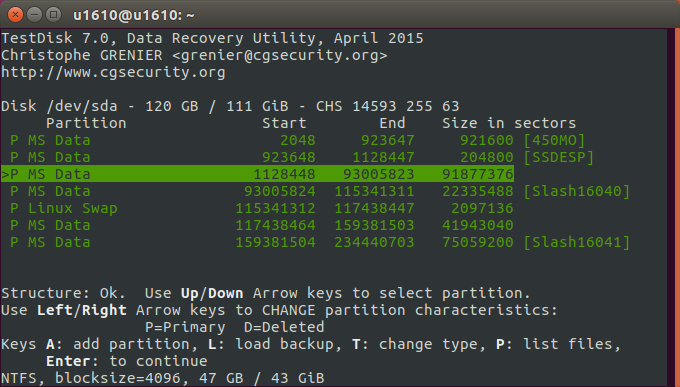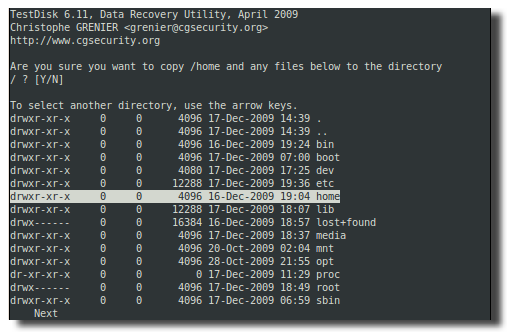

With a complete and current backup, you’re always free to wipe a drive if anything goes wrong. As always, you really should keep a good backup of your data.
Testdisk ubuntu software#
It’s important to note that TestDisk only takes care of software faults in a drive’s data, and will not save you in the event of physical failure. Once your files have been recovered by TestDisk, you can copy them to backup media. Once the scan is done and you see all the files, you can copy the files to backup media (like you, err, I, should The deeper scan will take some time, since TestDisk will read the entire partition, block by block. TestDisk will also look for file entries automatically, though damaged or deleted partitions will require a deeper scan. Once you see the drives, TestDisk will try to automatically detect the partitions, including those that have been deleted. If you’re unsure about where the drives you’re looking to recover are located, use the command lsblk to get more information. If no drives are found, you’ll need to specify the block device as an argument to TestDisk, e.g.: sudo testdisk /dev/sda. (You probably do.) From there, the program will look for any drives automatically. On the first run, TestDisk will ask if you want to start a new log file. While TestDisk is a console program, its menus and commands are easy to navigate even for people who aren’t command-line wizards. You’ll need to run it with administrator privileges: sudo testdisk.
Testdisk ubuntu install#
With Ubuntu running, install TestDisk using the command sudo apt-get install testdisk. You can use TestDisk as a rescue for Windows or Linux partitions, but you’ll need an Ubuntu live USB drive so you can boot into a separate environment on your PC, and then retrieve the lost files.


(You can delete the data itself too, but usually this requires deliberate deletion with tools like shred.) The deletion just removes the pointer to the data, allowing the the OS to write over those blocks. TestDisk’s website says the program is designed “to help recover lost partitions and/or make non-booting disks bootable again when these symptoms are caused by faulty software: certain types of viruses or human error (such as accidentally deleting a Partition Table).” One thing to understand about storage drives is that when you delete a file or partition table, the data is still on the disk. (It’s also available in the Arch Linux Extra repo.) It turns out it’s in the official Ubuntu repositories that ship with Ubuntu 16.04.

It works like a charm, but does so without the aid of a flashy GUI. TestDisk has been around for a while, and was even reviewed by PCWorld in 2011. It is labelled as a Flash Reader and is 2GB compared with the hard disk of 160GB.After a mild panic attack and several assurances to her that I could fix it, I found the program that saved my butt: TestDisk.
Testdisk ubuntu download#
To install from the tar download to the local computer and then There is a single package suitable for either i386 or AMD 64bit processors. For Linux it is available as either a tar.bz2 file or as an RPM. The program is available as a pre-built binary for each operating system. It should be similar whatever operating system is being used. Recovery is done on an EeePC netbook with hard disk drive and built-in SD card reader running Eeebuntu (Ubuntu based Linux distribution). These are based on recovery of photos from a Nikon D50 digital SLR. The following instructions are for use with Linux. I found TestDisk & PhotoRec, a disk / file recovery tool available free under the GPL from CG Security. The disk drive was faulty and damaged both my regular and backup floppy disks. Exact hits Package testdisk bionic (18.04LTS) (admin): Partition scanner and disk recovery tool, and PhotoRec file recovery tool universe 7. I thought it was a good opportunity to practice restoring files, something I've not really had to deal with since I lost half my 5,000 word essay stored on a floppy disk when I was at college. You have searched for packages that names contain testdisk in all suites, all sections, and all architectures. Ever had that sinking feeling when you format your SD card with all your precious holiday photos before suddenly realising that you hadn't actually copied them anywhere? In this case it turned out I did have a copy after all, it just happened to be on a different computer.


 0 kommentar(er)
0 kommentar(er)
